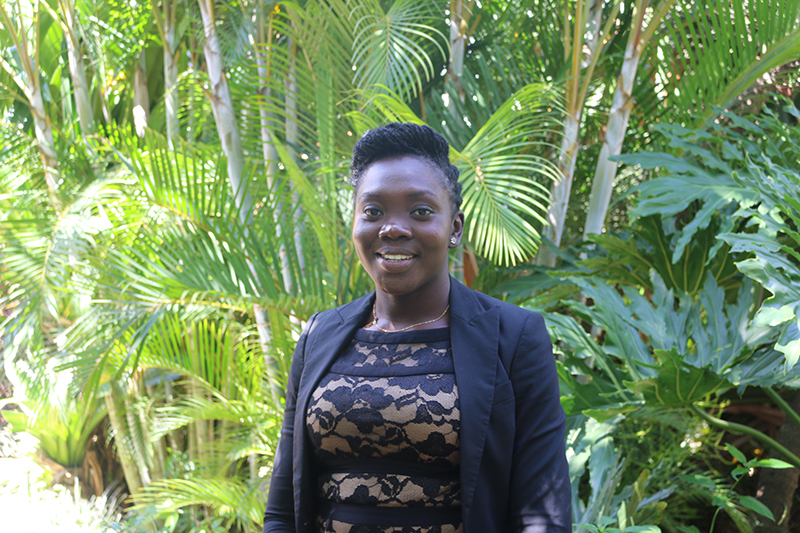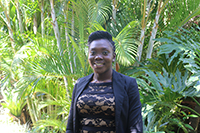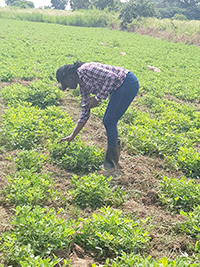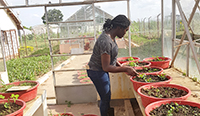Danielle Essandoh always liked plants, and as a girl at home in Accra, would bring leaves and other rubbish into the house from the garden. But, as she prepares to defend her master’s thesis for a degree in plant breeding from Makerere University in Uganda, she sees how her love of plants grew into a passion for helping people.
“As a young person, you want to do something for society. After my first degree, I visited some rural villages and so many people were complaining about pests and how they had to get pesticides from the government,” said Essandoh.
“I asked myself, ‘What if I could produce varieties that had resistance?’ Then, low-resource farmers wouldn’t have to worry about whether they could get pesticides or how. I think that’s where my passion came from, that I saw a way I could help those poor people,” she said.
Give a man a pesticide, he can protect his crop for a day. Give him an improved variety, and he can protect his crop forever.
Essandoh’s research contributes to the overall project led by Peanut Innovation Lab scientist Soraya Leal-Bertioli on the use of novel genetic diversity to improve peanut.
Specifically, the work could lead to improved varieties that can withstand two particular diseases that can destroy groundnut crops in eastern Africa – groundnut rosette disease (GRD) and late leaf spot (LLS).
Late leaf spot and groundnut rosette disease hurt yields across sub-Saharan Africa, impacting farmers that rely on the crop both for household consumption and income. Traditional breeding programs are working to improve resistance to GRD and LLS, but one of the challenges to breeding resiliency or other desirable traits into modern groundnut is the lack of genetic diversity among varieties.
The wild ancestors of groundnut, plants that come from South America, hold a treasure trove of genetic diversity. Leal-Bertioli and her husband, David Bertioli, have spent a decade constructing genetic maps to track/identify cryptic genes that were lost during domestication in modern peanut. Introgressing the genes – called alleles – back into modern peanut is challenging because the wild ancestors are diploid and modern peanut is tetraploid. The Bertiolis created synthetic allotetraploids using the wild diploid species at the University of Georgia. Those lines went to Senegal, where researchers at Centre d'Etudes Régional pour l'Amélioration de l’Adaptacion a la Secheresse grew advanced populations with the resiliency traits.
Those resultant plants then went to graduate student researchers like Essandoh, who works with David Okello Kalule, the head of Uganda’s groundnut breeding program.
Between October and January, Essandoh grew 376 lines from crosses of Fleur 11, a groundnut variety from Senegal, and the wild species. The test plots were at NaSARRI, in Serere district, and in Nakabango, in Jinja district.
Essandoh’s work involved growing out the crosses and evaluating them for yield and resistance to groundnut rosette disease and late leaf spot. Then, she hoped to identify quantitative trait loci (QTL) associated with resistance to the diseases.
Maintaining research plots at two locations during a pandemic was difficult, Essandoh said, but Kalule made it possible, ferrying grad students to the fields in his personal car when transit systems shut down.
“We had to manage,” she said. “Covid made us use our time wisely.”
“At first, we were concerned that we wouldn’t find any resistance because the lines had been backcrossed several times. But the wild alleles did show up and allowed us to find good lines that were resistant to those diseases and still very high yielding,” she said.
Twelve lines showed resistance to late leaf spot and 16 lines showed resistance to GRD. Seeing the result in the field was rewarding, Essandoh said, but tracing the resistant lines back to the wild alleles was even more exciting.
“I knew the lines had been backcrossed four times, so I didn’t really expect to find any QTLs for groundnut rosette disease, but I found four on the B genome. I was very excited, and it was a breakthrough for science for breeders looking for groundnut disease resistance,” she said.
“Groundnut rosette disease is a big deal in sub–Saharan Africa. Every single farmer cries about it, so to get QTLs that can be used for marker development … I am excited about it.”
Growing up in Ghana, Essandoh had a small garden, but hadn’t worked with peanut before coming to Uganda to attend Makerere University, 4,000 kilometers from home. She wanted the hands-on, intensive program that Makerere offered.
“In my final year at the University of Ghana, I did some plant breeding, but as soon as I started this program, I realized how much plant breeding entails,” she said. “But that’s why I chose the program. I didn’t want to just do theoretical work. I wanted hands-on experience.”
She got that experience through planning the research design, plotting the fields and planting, but also came to understand seed systems more thoroughly. The lessons of her fourth year at University of Ghana came together to form a complete picture in her mind.
“it was like a dream, seeing it all come together in my mind,” she said. “Breeding has moved away from just traditional work to more molecular breeding. Having experience in both makes you an excellent researcher,” she said.
Essandoh hopes to continue to work with groundnut, get a PhD and work full-time in research one day.










